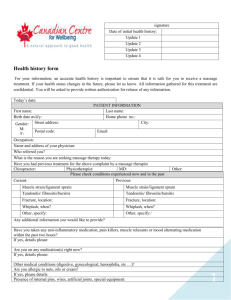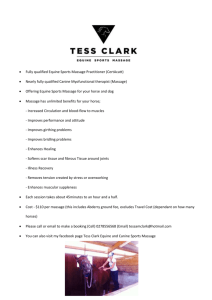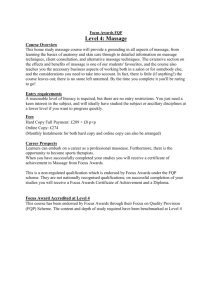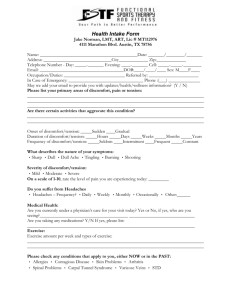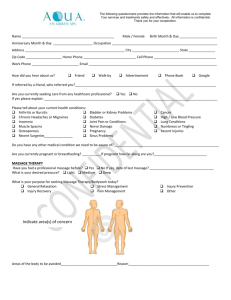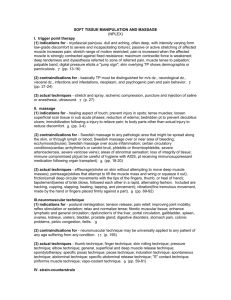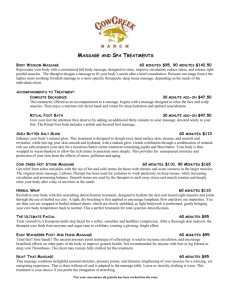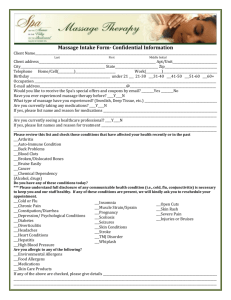EFFECT OF AROMA OIL MASSAGE AND HERBAL COMPRESSION
advertisement
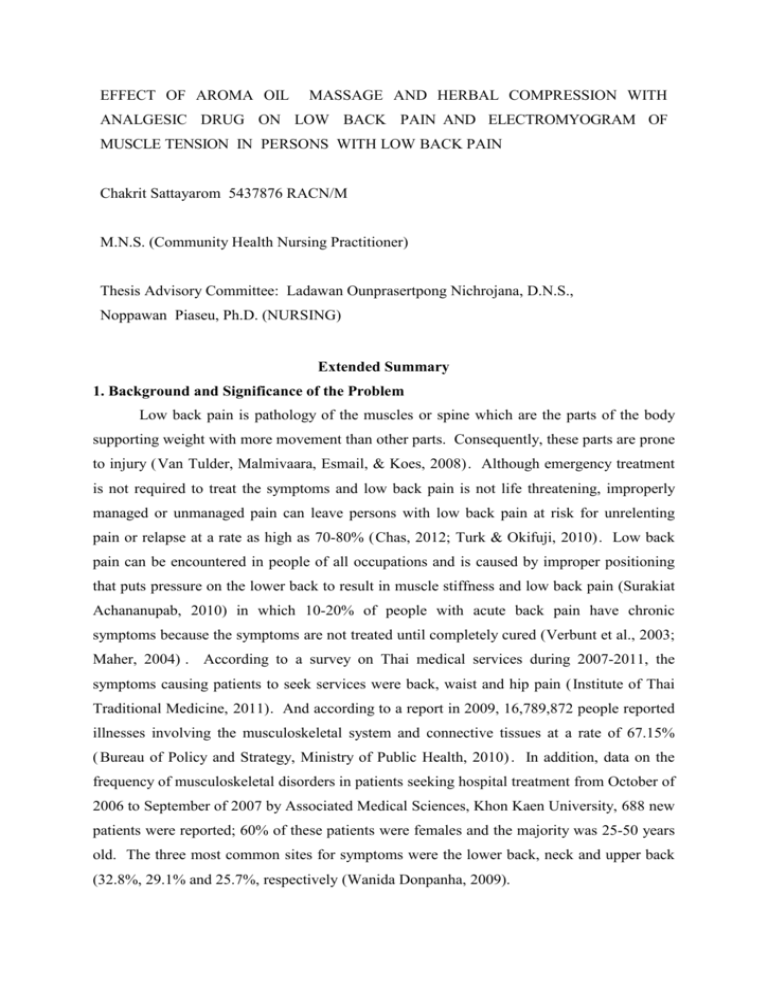
EFFECT OF AROMA OIL MASSAGE AND HERBAL COMPRESSION WITH ANALGESIC DRUG ON LOW BACK PAIN AND ELECTROMYOGRAM OF MUSCLE TENSION IN PERSONS WITH LOW BACK PAIN Chakrit Sattayarom 5437876 RACN/M M.N.S. (Community Health Nursing Practitioner) Thesis Advisory Committee: Ladawan Ounprasertpong Nichrojana, D.N.S., Noppawan Piaseu, Ph.D. (NURSING) Extended Summary 1. Background and Significance of the Problem Low back pain is pathology of the muscles or spine which are the parts of the body supporting weight with more movement than other parts. Consequently, these parts are prone to injury (Van Tulder, Malmivaara, Esmail, & Koes, 2008). Although emergency treatment is not required to treat the symptoms and low back pain is not life threatening, improperly managed or unmanaged pain can leave persons with low back pain at risk for unrelenting pain or relapse at a rate as high as 70-80% (Chas, 2012; Turk & Okifuji, 2010). Low back pain can be encountered in people of all occupations and is caused by improper positioning that puts pressure on the lower back to result in muscle stiffness and low back pain (Surakiat Achananupab, 2010) in which 10-20% of people with acute back pain have chronic symptoms because the symptoms are not treated until completely cured (Verbunt et al., 2003; Maher, 2004) . According to a survey on Thai medical services during 2007-2011, the symptoms causing patients to seek services were back, waist and hip pain ( Institute of Thai Traditional Medicine, 2011). And according to a report in 2009, 16,789,872 people reported illnesses involving the musculoskeletal system and connective tissues at a rate of 67.15% ( Bureau of Policy and Strategy, Ministry of Public Health, 2010) . In addition, data on the frequency of musculoskeletal disorders in patients seeking hospital treatment from October of 2006 to September of 2007 by Associated Medical Sciences, Khon Kaen University, 688 new patients were reported; 60% of these patients were females and the majority was 25-50 years old. The three most common sites for symptoms were the lower back, neck and upper back (32.8%, 29.1% and 25.7%, respectively (Wanida Donpanha, 2009). 2 The most common cause of low back pain is improper posture (Lewis & Colier, 2003) while 70-80% of the cause of low back pain are unidentified (Patpong Worapongpichet, 2006 ; Ponchai Dechanuwong, 2007). Apart from the aforementioned, still other back pain comes from injuries to the muscles or tendons in the back, or even agerelated degeneration that increases with age because certain areas are bent and curved combined with excessive weight and movement. These people might be found to experience back pain that may increase if other risk factors are present, namely, heavy workload on the back muscles and tendons, improper body posture, smoking, obesity and stress (Amnuay Unnanan, 2004). Although low back pain is not fatal, it has tremendous impact on a patient’s lifestyle causing physical, mental and economic problems (Sak Bawon, 2005). The impacts of low back pain hold affect patients, families, society and the nation with further impact on work-related duties and economic extravagance resulting from medical treatment and income lost due to the necessity to take days off work ( Waddell, 2008). One sixth of people with low back pain require bedrest with limited activity causing even more pain and suffering at least once in their lives (Wattana Chalaidecha, 2006). The aforementioned physical discomfort and limited activity prevent low back pain patients from returning to regular daily routines due to impaired ability to perform the activities and greater time requirements in completing routine activities than in the past. Consequently, mental impacts cause low back pain patients to be irritable as they are required to depend on other people. As a result, the patients have reduced self-worth which further affects work-related duties and economic extravagance spent in medical treatment costs with loss of income caused by time taken off work ( Waddell, 2008) . Furthermore, low back pain increases the burdens of family members who need to take the patients for treatment ( Kesorn Siangprao, 2009). Overseas studies have been conducted on expenses related to low back pain requiring hospital treatment, including time off work for recovery. According to the findings, large amounts of both time and money are lost. In 1998, the USA reported that the cost for treating patients with low back pain as high as 1,668 million dollars (Ceran & Ozcan, 2006). According to workmen’s compensation fund statistics in 2003, the pain of 4,977 low back pain patients was caused by lifting, moving heavy objects and using incorrect postures. This number increased to 7,486 patients in 2004 for a rate of 50.41 percent, which is correlated with the increasing expenses incurred in treating low back pain from 12,158,972 baht 23,389,065 baht ( Janya Jitrapinet, 2005) . The aforementioned impacts compel patients to 3 search for guidelines to treat their symptoms to help them return to their regular daily lifestyles and work (Anderson et al., 2003). Current low back pain treatment is composed of pharmacological and nonpharmacological treatments (Surasak Nilkanuwong, 2005). Pharmacological treatment may result in complications such as gastrointestinal bleeding, inflammation of the liver, renal impairment and potentially life-threatening allergies to medication ( Surakiat Achanuphap, 2010; McPhee, Tiemey & Papadakis, 2007) . Non-pharmacological treatments include offering advice on weight loss, correct posture and movement, physical therapy and alternative medicine. In particular, aroma oil massage and herbal compression with the use of analgesic drugs have been used to enhance treatment effectiveness for low back pain because no singular medical science in the work is capable to treat or cure every ailment. Every medical science has its weaknesses and gaps to make it incomplete ( Ladawan Ounprasertpong Nichroj, 2012). According to the reports on studies conducted by the World Health Organization (WHO) (2006) and and Gaston – Johansson ( 2005 ) , analgesic drugs were found to be considered a significant contributor to pain relief with effectiveness at a rate of 70 – 90 percent. Another 10-30 percent, however, report analgesic drugs as being unable to relieve pain. Consequently, other medical treatments and fields apart from pharmacology must be considered in order to help manage pain more completely with the promotion of holistic healthcare referred to as integrated healthcare ( Ladawan Ounprasertpong Nichroj, 2 0 1 2 ) . The abovementioned concurs with the policy of the Ministry of Public Health in promoting the arrangement of Thai medical services in medical facilities in order to ensure that service recipients have access to Thai medical treatment and alternative medicine within the national health guarantee system which has been accredited for meeting standards and quality with greater convenience ( Bureau of Health Administration, Department of Health Service Support, Ministry of Public Health, 2009) . The Bor Suphan Health Promoting Hospital is a primary public health unit providing Thai medical services since the 2009 fiscal year. And the service recipients encountered in the group with musculoskeletal conditions are on the rise. The same is true with the situation of persons with low back pain in the province of Suphanburi. The out-patient data of the Suphanburi Public Health Office in 2010 – 2012 discovered patients with musculoskeletal and connective tissue disorders at 148,131, 196,358 and 219,221 people (Suphanburi Public Health Office, 2012) while the out-patient data from Bor Suphan Health Promoting Hospital discovered patients with pathologies of the 4 musculoskeletal system and connective tissues in 2010 – 2012 to have increased dramatically from 6,934 to 7,125 and 8,013 cases. The aforementioned data is from patients with low back pain at 2, 082, 2314 and 2, 678 cases, respectively ( Bor Suphan Health Promoting Hospital, 2012). At the same time, the use of non-steroidal analgesic drugs in patients with low back pain is being recognized is on the rise. In 2010-2012, the percentage of patients in this category increased from 29.9 percent to 34.1 percent and 36.7 percent, respectively (Bor Suphan Health Promoting Hospital, 2012). According to the background and significance of the problem as stated above and previous literature reviews, insufficient data has been discovered in the form of evidencebased practice to prove the effects of aroma oil massage and herbal compression with analgesic drugs on low back pain with electromyograms of muscle tension. The role of professional nurses is to study and train in order to obtain practical skills to prepare nursing personnel at the graduate level with ability to integrate alternative medicine and healthcare to properly treat illnesses and symptoms. Thus, the researcher is interested in conducting additional study to improve and develop a study that is scientific evidence associated with the effects of aroma oil massage and herbal compression in response to the policy of the Ministry of Public Health in promoting the application of indigenous Thai wisdom and alternative medicine in self-care. 2. Conceptual Framework The present study investigated the effects of aroma oil massage and herbal compression with analgesic drugs on low back pain and electromyogram muscle tension in persons with low back pain by employing the Gate Control Theory as the conceptual framework for the study because low back pain tends to occur as a result of work or carrying excessively heavy loads (McPhee, Tiemey & Papadakis, 2007) until the person suffers which is an experience occurring according to the individual perceptions of each person. Aroma oil massage in kaffir fragranced mixed with lavender us used to apply Swedish massage composed of stroking/effleurage, superficial stroking, deep stroking, compression movement, kneading/petrissage, picking up and rolling) ( Ladawan Ounprasertpong Nichroj, 2012) . Massage raises the temperature of the skin in the area massaged which causes the blood vessels to dilate as hard, constricted muscles relax and the circulation of blood and lymphatic fluid is increased in the areas massaged with aroma oil massage and herbal compression. Hence, the tissues receive increased nutrients and oxygen from the increased metabolic rate 5 inside the cells as waste inside the muscles is reduced. Moreover, aroma massage with herbal compression stimulates the beta and alpha nerves to send stronger and faster neurotransmissions. Thus, the neurotransmissions of pain sent by the beta nerves result in increased secretions from the brain to the SG cells to reduce the neurotransmission to the cells as the pain control gate closes. The results are decreased perceptions associated with pain, low back pain and electromyogram muscle tension ( Thai Association for the Study of Pain, 2009; Melzack & Wall, 1965). After aroma massage, herbal compression is applied. The main components of the herbal compresses are Thai plai oil, which has analgesic effects; turmeric, which has antiinflammatory effects and acts as a natural steroid and wax leaved climber helps relax hardened tendons. In addition, camphor is used to help relieve pain and acts as a local anesthetic. Heat and the properties of the aforementioned herbs is deeply absorbed by the skin (1-2 centimeters) into the tissues in the at the compression site with sodium as the conductor of the heat from the compress. Hence, the skin in the compression area rises in temperature to 40-45 degrees Celsius ( Ladawan Ounprasertpong Nichroj, 2 0 1 2 ) , thereby causing the muscles, tendons and connective tissues to relax. The blood vessels dilate more, which sends nutrients to the aching muscles, tendons and connective tissues as inflammatory substances such as prostaglandins and bradykinin, etc. are drained. Once these substances are reduced, the tissues will receive more oxygen ( Sasikarn Nimmanarach, Wongchan Petchapisetchian and Chachai Preechawai, 2009) and low back pain lessens. Furthermore, herbal compresses contain the aromatic fragrances of Thai plai oil, kaffir peel, turmeric, camphor and lavender oil mixed with the aroma oils used in massage which pass through the nasal tissues to relax persons suffering from low back pain to a high degree, thereby affecting the limbic system in the brain and causing secretions with morphine-like effects from the center of the brain such as endorphins, encephalin, etc., to result in both physical and mental relaxation (Ladawan Ounprasertpong Nichroj, 2012). In addition, diclofenac sodium has the effect of inhibiting the production of the enzyme, cyclooxygenase that is used in the chemical transformation of arachidonic acid into the substrate in the production of prostaglandins, a substance causing pain and inflammation leading to low back pain. Furthermore, receipt of tolperisone hydrochloride has the effect of reducing the attachment of acetylcholine to the receptor cells of the striated muscles, thereby leading to sodium-potassium exchanges as the sodium-potassium voltage gate process 6 decreases ( Pawitra Phulbudt, 2 0 0 9 ; Pongsathorn Meesawasdesom, 2 0 0 9 ) . Hence, the constriction of the muscles at the depolarization stage, which is the phase where the muscles become tense, lessens. At the same time, the effects of the medication cause the repolarization stage, or the resting phase of muscle constriction, cause the muscles to relax longer. Thus, muscle tension is relieved ( Pawitra Phulbudt, 2 0 0 9 ; Pongsathorn Meesawasdesom, 2 0 0 9 ) . The conceptual framework of the study can be summarized as follows: Diagram 1 - Conceptual Framework of the Study 7 3. General Research Objective To study the effects of aroma oil massage and herbal compression with analgesic drugs on low back pain and electromyogram of muscle tension in persons with low back pain. 4. Specific Research Objectives 4.1 To compare low back pain and electromyogram of muscle tension in persons with low back pain before and after receiving aroma oil massage and herbal compression with analgesic drugs. 4.2 To compare low back pain and electromyogram of muscle tension in persons with low back pain between subjects receiving aroma oil massage and herbal compression with analgesic drugs and subjects receiving analgesic drugs only. 5. Research Hypotheses 5.1 The low back pain and electromyogram of muscle tension in the subjects with low back pain receiving aroma oil massage and herbal compression with analgesic drugs will be relieved more effectively than the pain of the subjects receiving analgesic drugs only. 5.2 After receiving aroma oil massage and herbal compression with analgesic drugs, the low back pain and electromyogram of muscle tension in persons with low back pain will be less than the pain before receiving aroma oil massage and herbal compression with analgesic drugs. 6. Methodology This research is randomized control clinical trial (pretest and posttest designs with a comparison group) (Burns & Grove, 2009) conducted to study the effects of aroma oil massage and herbal compression with analgesic drugs on low back pain and electromyogram of muscle tension in persons with low back pain. 7. Population and Sample Group 7.1 The target population used in conducting the present study comprised persons with symptoms of low back pain diagnosed with low back pain by a physician. 7.2 The sample group used in the present study comprised 60 persons with symptoms of low back pain diagnosed with low back pain by a physician and who received services at Bor Suphan Health Promoting Hospital, Songphinong, Suphanburi, between 1-31 July 2013. The participants possessed characteristics meeting the following criteria: 8 7.2.1 Inclusion Criteria 7.2.1.1 Physician’s diagnosis with low back pain. 7.2.1.2 A pain score of six points or more as evaluated on a numerical pain scale. 7.2.1.3 Males or females aged 25-55 years old. 7.2.1.4 Body mass index not exceeding 25 kg/m2. 7.2.1.5 Administration of diclofenac sodium 25 mg. and tolperisone HCl 50 mg at a dosage of one tablet three times a day to relieve low back pain. 7.2.1.6 Ability to listen, read, speak and understand the Thai language. 7.2.1.7 Willingness to participate in the research during the designated time schedule with signed consent. 7.2.2 Exclusion Criteria 7.2.2.1 A history of allergies to herbs, sesame oil, or kaffir or lavender aroma oils. 7.2.2.2 Abnormalities associated with sensory perception in the low back area and restrictions concerning herbal compression, for example, communicable skin diseases such as chicken pox, herpes zoster (shingles), leprosy, etc., with open sores in the low back and nearby areas. 7.2.2.3 Plans to undergo surgery for herniated or prolapsed spinal discs. 7.2.2.4 Receipt of low back pain treatment by injection and/or topical medication no more than seven days before the experiment. 7.2.2.5 Receipt of treatment from any other institution or service unit by using alternative medicine services with effects on low back pain no more than seven days before participating in the research. 7.2.2.6 Restrictions concerning massage and herbal compression: 1) High fever of 38.5 degrees Celsius or more. 2) Pregnancy. 3) Heart disease or epilepsy. In addition, if any of the subjects participating in the study were found to be unable to endure heat, to exhibit allergic reactions to the herbs, to have undergone massage and herbal compression from another institution during the course of the study or 9 fail to fully participate in the research according to the designated schedule, consideration must be given to terminating criteria. 7.2.3 Sample Size Determination In the present study, the sample group size was determined by using Cohen’s power analysis table (Cohen, 1988) as cited in the literature review by Tipparat Udomsuk in which power = .80; significance = .0, one –tailed; and substituted made in Glass’s formula (Glass, 1979). The effect Size (ES) was calculated at 1.92 with one way. When compared to the table designating the sample size by using t-test, a sample group size of twenty subjects was obtained. In order to ensure the research had a sample group size sufficiently large in line with preliminary agreement of parametric statistics and to compensate for sample attrition, two sample groups with thirty subjects each were set for a total of sixty people. 7.2.4 Random Sampling - In the present study, the researcher selected people with low back pain according to the qualities set by the inclusion criteria and randomly assigned the subjects to experimental or control groups by using a simple random sampling method by drawing lots with “E” for the experimental group and “C” for the control group. Next, the researcher employed systematic random sampling for the selection from patients with low back pain seeking services each day until thirty subjects were recruited for each group. The participants were unaware of the group assignments. 8. Research Site The site used for data collection in the present study was the Out Patient and Traditional Thai Medicine Departments at the Bor Suphan Health Promoting Hospital, Songphinong, Suphanburi providing examination and treatment services for disease and accidents/emergencies from Monday thru Friday, 8:30 am to 8:30 pm and on Saturdays and holidays from 8:30 am to 4:30 pm. A doctor is regularly on duty on official work days during office hours. There are approximately 100-150 service recipients per day with a daily mean of 10-15 patients receiving traditional Thai medicine services. 9. Research Instrumentation and Instrument Quality 10 The instrumentation employed in the present study was divided into two parts, namely, 1) instruments used in data collection and 2) instruments used in testing. The instruments are described as follows: 9.1 Data Collection Instruments 9.1.1 Demographic Data Questionnaires composed of data on gender, age, religion, marital status, educational attainment, occupation, family income, duration of low back pain, cause of low back pain, medication side-effects, low back pain management method and history of chronic disease. The questionnaires contain questions concerning low back pain. Content validity was examined by a panel of three experts, namely, a musculoskeletal physician specialist, university professors with expertise in pain and the musculoskeletal system. Following the examination of the experts, the instrument was revised and improved in concurrence with the recommendations of the aforementioned before using the instrument to collect data. 9.1.2 Low Back Pain Assessment Questionnaire – A numeric pain intensity scale with scores ranging from 0-10 points was used (McCaffery & Pasero, 1999) in which the left-hand side meant “no pain” and the right-hand side meant “most pain”. The subjects with low back pain were instructed to mark the spot indicating their pain intensity on the aforementioned scale. The interpretation criteria for pain intensity was as follows: 0 points indicated no pain; 1-3 points indicated mild pain; 4 – 6 points indicated moderate pain; 7 – 9 points indicated intense pain; and 10 points indicated unendurable pain. 9.1.3 Diclofenac Sodium 25 mg. and Tolperisone HCl 50 mg Record Form and the electromyogram muscle tension record form created by the researcher. Content validity was examined by Assistant Professor, Dr. Ladawan Ounprasertpong Nichroj. Once the instrument had been revised and improved as recommended, data was collected on electromyogram muscle tension. 9.2 Testing Instruments 9.2.1 The aroma oil massage instruments comprised the following equipment: 1) aroma massage oil mixed by the researcher with the eight drops each of kaffir and lavender scents with 30 milliliters of sesame oil as the carrier; 2) a watch to time the massages; 3) a large cloth covering for the subjects. 9.2.2 The herbal compression instruments comprised the following equipment: 1) two dry herbal compresses; 2) a towel to cover the compresses; 3) a tray for placing the 11 compresses; 4) an electrical steam pot; 5) a watch to time the steaming of the herbal compresses. 9.2.3 Dry herbal compresses made by Assistant Professor, Dr. Ladawan Ounprasertpong Nichroj which had been certified for meeting Thai Community Product Standards, No. TCPS.176/2546. The compresses contained 100 grams composed of 31.25 grams of Thai plai oil, 6.68 grams of turmeric, 9.37 grams of kaffir peel; 4.68 grams of wax leaved climbers ½ teaspoon of camphor, ½ teaspoon of salt and other ingredients. 9.2.4 An aroma oil massage and herbal compression handbook developed by the researcher which was modified from video on a complete version of aromatic oil massage and aromatherapy and symptom relief by Assistant Professor, Dr. Ladawan Ounprasertpong Nichroj ( 2009). The instrument was validated by Assistant Professor, Dr. Ladawan Ounprasertpong Nichroj and university nursing instructors who had experience in research involving aromatic oil massage. The researcher revised and improved the instrument according to the recommendations of the aforementioned before conducting the research. 9.2.5 The researcher and Two Sets of Research Assistants –The first set of research assistants were professional nurses who had been nurses for three years and received explanations and instructions on the guidelines and procedures for data collection. The aforementioned performed the tasks of collecting the sample group’s demographic data and assessment of low back pain and electromyogram of muscle tension. The second set of research assistants were traditional Thai medicine staff who had received skills training in aroma oil massage and herbal compression from the researcher performed the aromatic oil massage and herbal compression on the subjects. Each research assistant massaged no more than five people per day for thirty minutes per person with 15-minute breaks between massages. 9.2.6 Electromyography Biofeedback Model ProComp Infiniti for measuring electromyogram of Quadratus lumborum muscle tension. The machine was inspected by a specialist from an agency selling the machine to ensure accuracy and reliability before use. 10. Data Collection The researcher collected the data for the present study by designating the following procedures and guidelines: 10.1 Pre-Study Preparations 12 10.1.1 The researcher submitted a letter of introduction to request for data to the director of Somdejprasangkharach XVII Hospital, Songphinong Public Health Office, and the director of the Bor Suphan Health Promoting Hospital, Songphinong, Suphanburi, to request cooperation in preparing the sample group records and data for the research. 10.1.2 The researcher attended instruction and skill training in traditional Thai medicine and alternative medicine as follows: 1) Instruction in aromatic oil massage and herbal compression with additional skills training in aromatic oil massage for 14 service recipients, spending two hours for each person for a total of 60 hours. 2) An instructional course on the subject of alternative medicine and nursing supplementary therapy with topics involving herbal compression, herbal compression skills, neck and shoulder massage and healthcare, usage, checking and setting of the EMG biofeedback machine. 10.1.3 Two Sets of Research Assistants – The first set of research assistants were professional nurses who had received explanations on the guidelines and procedures for data collection, the methods for interviewing on the sample group’s demographic data, pain assessment and recording, electromyogram of muscle tension assessment and recording and training in the use of the EMG biofeedback machine in order to ensure that the research assistants achieved skill and expertise in data collection. The second set of research assistants comprised traditionsl Thai medical staff who had passed a skill training course in aroma oil massage and herbal compression; the assistants were also given the aforementioned handbook to take home for study and review. 10.1.4 Research Site – The researcher submitted letters requesting permission to collect data to the Songphinong Public Health Office and the director of the Bor Suphan Health Promoting Hospital. The site was set up separately from the general service area. Next, the researcher explained the research guidelines to the traditional Thai medicine staff. 10.2 Data Collection Preparations 10.2.1 The researcher introduced himself, explained the research objectives, data collection procedures and research schedule. The researcher assured the subjects that all data would be kept confidential and presented only from an aggregate perspective. The researcher then requested cooperation in research participation. The recruits who were willing to participate in the study were instructed to sign informed consent forms. Next, the 13 samples were selected from people with lower back pain using the inclusion criteria. Simple random sampling was performed daily to assign the sample group to either the control or experimental group by means of drawing lots. The tickets were labeled “E” for the experimental group and “C” for the control group. Next, systematic random sampling was performed on all people with low back pain seeking treatment each day until thirty subjects had been obtained for each group. The researcher then referred the sample group to the Traditional Thai Medicine Department at the site prepared in advance for conducting the study. 10.3 Data Collection 10.3.1 Pretest data collection was conducted before assigning the participants to the control and experimental groups. Next, the researcher and research assistants conducted interviews on demographic data and assessed low back pain and electromyogram muscle tension in the control and experimental groups. 10.3.2 The researcher commenced the experiment by testing for allergic reactions by using pre-mixed aromatic oil to rub the inner side of the arm on an area the size of a five-baht coin and waiting for five minutes. If a red rash occurred, the massage would not be performed due to the allergic reaction to the aromatic oil (Surapoaj Wongyai, 2011), and the experiment would be terminated. If there were no signs of an allergic reaction, aromatic oil massage and herbal compression would be performed by traditional Thai medicine staff according to the procedures and schedule. The subjects were also given one tablet of 25-mg diclofenac sodium and one tablet of 50-mg tolperisone HCl three times a day for three days. During the aromatic oil massage and herbal compression, the research assistants were asked to remain calm and concentrate on the massage to ensure the sample group was able to rest and obtain optimal benefits. The control group received one tablet of 25-mg diclofenac sodium and one tablet of 50-mg Tolperisone HCl three times a day for three days and the medication adherence was recorded. All of the subjects were instructed to not receive treatment or therapy for low back pain elsewhere or by other methods. 10.3.3 Post-Test Data Collection, - After three days of experimentation, the researcher and research assistants conducted interviews on demographic data and assessed lower pain and electromyogram of muscle tension in the control and experimental groups. 10.3.4 At the end of the experiment, the control group received aroma oil massage and herbal compression for thirty minutes per person and all of the subjects received 14 the instructional handbook for people with low back pain which had been modified by the researcher from Thipsuda Lappakdee (2008). Each of the subjects was also given an herbal compression ball to practice healthcare independently. 11. Data Analysis 11.1 The researcher used descriptive statistics to analyze demographic data such as gender, age, religion, marital status, educational attainment, occupation, family income, pain duration, causes, side effects, pain management methods history of chronic illness. These data were analyzed by frequency distribution and calculated for percentage, mean, standard deviation, maximum and minimum values. 11.2 Paired t-test was used to compare the differences in the mean pre- and post-test low back pain and electromyogram of muscle tension scores for the experimental group before and after aroma oil massage and herbal compression with analgesic drugs. Independent t-test was used to compare the differences in the mean low back pain and electromyogram of muscle tension post-test scores between the experimental group receiving aroma oil massage and herbal compression with analgesic drugs and the control group receiving analgesic drugs only. 12. Findings The present study comprised random sampling research aimed at exploring the effects of aroma oil massage and herbal compression with analgesic drugs on low back pain and electromyogram of muscle tension in persons with low back pain. The sample group was composed of 60 subjects. Thirty of the subjects were assigned to the control group and the other thirty subjects were assigned to the experimental group; 53.33% of the subjects were males and 46.67% were females; 46.67% were 36-46 years of age with a mean age of 40.70 years. A hundred percent of the subjects were Buddhists; 68.33% were married and living with spouses; 50.00% were primary and secondary school graduates; 40.00% had agriculturerelated occupations and 56.67% had mean family incomes between 5,000-10,000 baht/month. When demographic data on gender, age, religion, marital status, educational, occupation and average family income were tested for similarities among the variables by using chi-square statistics, no differences with statistical significance were encountered at p>.05 (2= .268, p = .605, 2= 2.819, p = .244, 2= .077, p =.781, 2= -, p = 1.000, 2=1.418, p = .4921, respectively). 2=.444, p = .801, 15 Concerning history of lower back pain, 56.67% of the sample group reported having had lower back pain for 1-2 years. With regard to the causes of lower back pain, 95.00% was due to the fact that the body was required to carry excessively heavy loads; 88.33% of the sample group had no medication-related side effects; 96.67% of the sample group managed low back pain by administering the drug themselves. In terms of chronic disease, 78.33% of the sample group had no chronic diseases; 55.00% of the sample group had normal BMI. When data on history of lower back pain, namely, duration of the condition, causes, side effects, previous pain management methods, chronic disease and body mass index, were tested on for similarity among the variables by using chi-square statistics, no differences with statistical significance were encountered at p >.05 ( 2= .601, p = .438; 2= 2.654, p =.845; 2= .875, p = .350; 2= 1.975, p =.975; 2= .098, p =.754; 2= 1.647, p =.619, respectively). The findings on the sample group’s level of low back pain revealed the subjects’ lower back pain to be moderate and severe in intensity (56.67% and 43.33%, respectively) before the aroma oil massage and herbal compression with analgesic drugs. After the aroma oil massage and herbal compression with analgesic drugs, the control group’s lower back pain remained moderate (50%), but the experimental group’s lower back pain was mild (100%) as shown in Table 1. Table 1 - Number and percentage of sample group classified by pre- and post-test low back pain intensity. Control Group (n= 30) Level of Pain Severity Amoun Group (n=30) % t Experimental Amou nt % Entire Sample Group (n=60) Amou nt % Pre-Test Level of Low Back Pain Severity Moderate Pain 18 60.00 17 56.67 35 58.33 Extreme Pain 12 40.00 13 43.33 25 41.67 30 100.0 42 70.00 Post-Test Level of Low Back Pain Severity Mild Pain 12 40.0 16 0 Moderate Pain 15 Extreme Pain 3 0 50.0 15 25.00 3 5.00 0 10.0 0 The comparison of the pre- and post-test mean low back pain and electromyogram of muscle tension scores revealed the low back pain and electromyogram of muscle tension of the experimental group receiving aroma oil massage and herbal compression with analgesic drugs to be lower than the control group receiving analgesic drugs only with statistical significance (p<.001) as shown in Table 2. Table 2 - Comparison of the mean pre- and post-test low back pain and electromyogram of muscle tension scores between the control and experimental groups using paired ttest. Variable Control Group (n=30) Min Max Experimental Group (n=30) Mean S.D. Min Max Mean S.D. t p Low Back Pain Pre-Test 6 8 6.47 .629 6 8 6.50 .630 -.205 .838 Post-Test 3 7 5.17 .874 2 3 2.47 .507 14.630 <.001 21.19 11.92 3.53 .071 .944 9.10 5.13 1.49 9.543 <.001 11.76 <.001 Muscle Tension Reflex Reaction Pre-Test 7.89 21.36 11.98 3.50 7.31 Post-Test 6.89 22.02 11.65 3.42 3.38 Pre- and Post-Test Differences in Muscle Tension Reflex Reaction 1.00 0.66 0.33 0.08 3.93 12.09 6.79 2.79 The comparison of the pre-and post-test mean low back pain and electromyogram of muscle tension scores revealed the low back pain and electromyogram of muscle tension of the experimental group receiving aroma oil massage and herbal compression with analgesic drugs to be lower than before the experiment with statistical significance (p<.001) as shown in Table 3. Table 3 - Comparison of the pre-and post-test mean low back pain and electromyogram of muscle tension scores by using paired t-test. 17 Variable Mean S.D. Mean S.D. Mean difference difference 4.03 .12 25.981 <.001 6.79 2.04 13.347 <.001 t p Low Back Pain Pre-Test 6.50 .63 Post-Test 2.47 .51 Muscle Tension Reflex Reaction Pre-Test 11.92 3.53 Post-Test 5.13 1.49 13. Research Limitations 13.1 This study included four research assistants with three years of experience in traditional Thai medicine. This could affect the massaging postures because Thai massage generally requires more pressing force than the Swedish massage used in this study. 13.2 The research participants had agricultural occupations and had to work daily. Despite the researcher’s request for cooperation in avoiding work or lifting heavy loads, some of the participants still needed to perform the aforementioned tasks, which might have resulted in an external variable. Furthermore, the researcher was unable to control and maintain the stability of the factors associated with the participants’ occupations. 14. Recommendations 14.1 Nursing Practice – According to the findings, the effects of aroma oil massage and herbal compression with analgesic drugs on low back pain and electromyogram of muscle tension can relieve low back pain and muscle tension with relaxation and comfort. Thus, aroma oil massage and herbal compression should be promoted and combined with modern medicine to ensure that service recipients receive holistic care. 14.2 Nursing Administration - Aroma oil massage and herbal compression relieve low back pain and muscle tension when administered with the right model. Thus, nursing administrators should promote capacity development to ensure that nursing staff and the healthcare teams gain knowledge and skills for the implementation of the knowledge in traditional Thai medicine clinic effectively and safely in compliance with policy for promoting traditional Thai medicine and alternative medicine set forth by the Ministry of Public Health. 18 14.3 Nursing Education – The effects of aroma oil massage and herbal compression indicate the aforementioned as alternative traditional Thai medicine offering effective and safe integration with modern medicine as a complementary solution. In addition, the aforementioned are within the scope of professional nursing tasks. Thus, traditional Thai medicine and alternative medicine should be taught at university and post-graduate levels. Furthermore, training and special courses should be offered to improve nursing roles and capacity in order to produce graduates with knowledge and ability in multiple fields of science who can go out and serve society to support healthcare in ASEAN. 14.4 Nursing Research - Because aroma oil massage and herbal compression can relieve low back pain and muscle tension, offering relaxation and comfort within thirty minutes following the massage and herbal compression, studies should be conducted to study the effectiveness of aroma oil massage and herbal compression to determine the duration of the aforementioned effects.
